Chapter 5
Hashtag Recall: The Telidon Art Collection
"Vision is the art of seeing what is invisible to others."
- Jonathan Swift
Around 2014, Clint Enns, a Ph.D. student at York University, curated a screening of early Canadian computer art. Enns found the tape at Canada's VTape project, the largest distribution center for video art in Canada and an archive of videotapes.
Clint Enns had discovered a magnetic videotape labeled "Canadian Artists and Telidon - an anthology of early works by Canadian artists." The label went on to list that a certain P. Petro had produced and curated the video recording.
The videocassette format was not the common VHS or Betamax of the early 1980s. Rather, it was a high-quality recording on a Sony U-Matic videocassette (model KCA20). At the time the recording was created, this format was only used in highly specialized circumstances (e.g. TV stations and archives). As opposed to the consumer-grade VHS and Betamax and their grainy image quality, the U-Matic's great strength was the recording of still picture reproduction.
The tape had 20 minutes of direct recordings of video art from the screens of Telidon terminals. Clint Enns stated that "I was totally blown away... it had an aesthetic that I hadn't seen before."[42] He found "lots of spacial studies, lots of color studies, lots of trying to see what the medium could do." Enns decided to investigate. All he had was the name of the system and the name of the curator.
While this video recording proved to be the most important key to Telidon's rediscovery, it was clear to Enns that this magnetic tarpit that preserved the art was an incomplete representation of the system. The recording only showed images and animations. Telidon was interactive.
Clint Enns quickly found the person behind the name "P. Petro" — it was artist and curator Paul Petro, founder of the Toronto Community Videotex, later renamed to Inter/Access. Petro was not an unknown in the art community of Toronto.
Inter/Access[43] is a collaboration between the Centre for Contemporary Canadian Art (CCA) and the Canadian Museum of Contemporary Art in Toronto. It is an artist-maker space with a large archive of old media.
Coming out of the Toronto Community Videotex, it was founded in its present form in 2003 with the mission to serve as an artist's "access center to give something back to their local community." Inter/Access is supported by the Canadian Museum of Contemporary Art (CCA).
Telidon Art on Instagram
Petro and his Inter/Access team moved forward quickly to find a way to exhibit the newly found Telidon artwork. Having it printed and exhibited in a physical gallery was a good first step, but not the ideal medium to expose Telidon to a large audience.
That is when they decided to use Instagram.
Doherty and Denise Chan at Inter/Access began preparing a #telidon Instagram campaign. They meticulously digitized the available Telidon art and created in-depth descriptions of the pieces. To coincide with the 35th anniversary of Telidon in 2018, Inter/Access curated an Instagram social media campaign. Each week from April to June 2018, they posted stills and videos created using Telidon. On the Instagram account @interaccess to feature works by the artists Bill Perry, Adele D'Arcy, Paul Petro, Robert Flack, Dennis Day, Douglas Porter, Pierre Rovere, Nell Tenhaaf, Johanne Daoust, and Nina Beveridge.
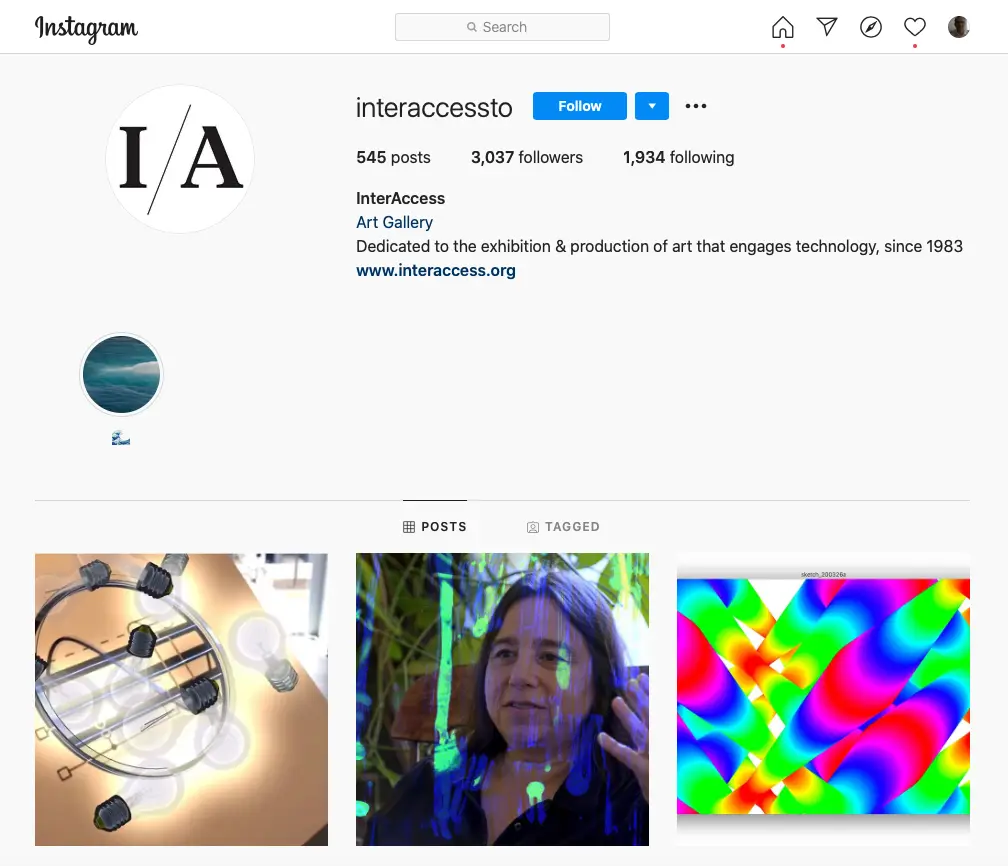
Figure 17: The Inter/Access Instagram Channel. Source: https://www.instagram.com/interaccessto/?utm_source=ig_embed (retrieved on April 27, 2020)
All Your Posts are Belong to Us
The online exhibition included the following Instagram posts (retrieved on April 12, 2020):
April 6, 2018, works by Bill Perry
Source: https://www.instagram.com/p/BhPJVIpHo2y/?taken-by=interaccessto
April 13, 2018, works by Adele D'Arcy
Source: https://www.instagram.com/p/BhhBxuFncRk/?taken-by=interaccessto
April 20, 2018, works by Nell Tenhaaf
Source: https://www.instagram.com/p/BhysmdeHC0Z/
April 27, 2018, works by Douglas Porter
Source: https://www.instagram.com/p/BiFFjqxHipH/
May 4, 2018, works by Robert Flack
Source: https://www.instagram.com/p/BiXJuo_nOiK/?taken-by=interaccessto
May 11, 2018, works by Pierre Rovere
Source: https://www.instagram.com/p/Bip16e5HIAT/?taken-by=interaccessto
May 25, 2018, works by Dennis Day
Source: https://www.instagram.com/p/BjNSvLXnO1x/
June 1, 2018, works by Paul Petro
Source: https://www.instagram.com/p/BjfMqJHnum2/?taken-by=interaccessto
June 8, 2018, works by Johanne Daoust
Source: https://www.instagram.com/p/BjxNVKXHotP/?taken-by=interaccessto
June 15, 2018, works by Nina Beveridge
Source: https://www.instagram.com/p/BkDc6FuHMxk/?taken-by=interaccessto
Excerpts From the Collection

Figure 18: Three excerpts from the collection on Instagram. (retrieved on April 27, 2020)
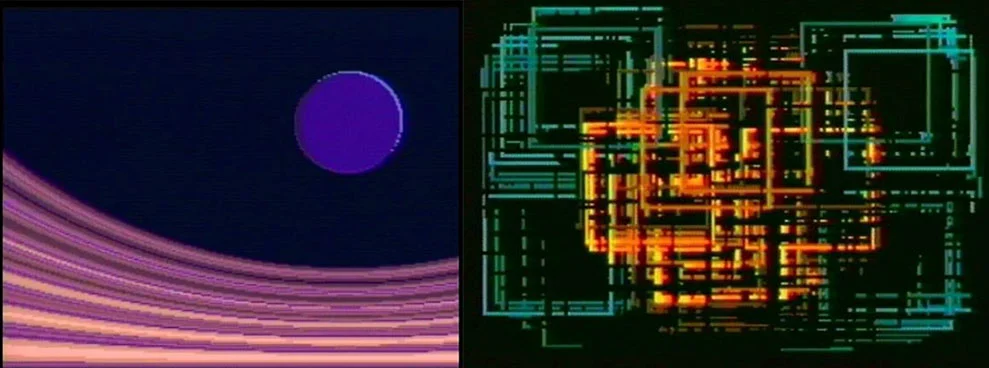
Figure 19: Two more Excerpts from the collection on Instagram. (retrieved on April 27, 2020)
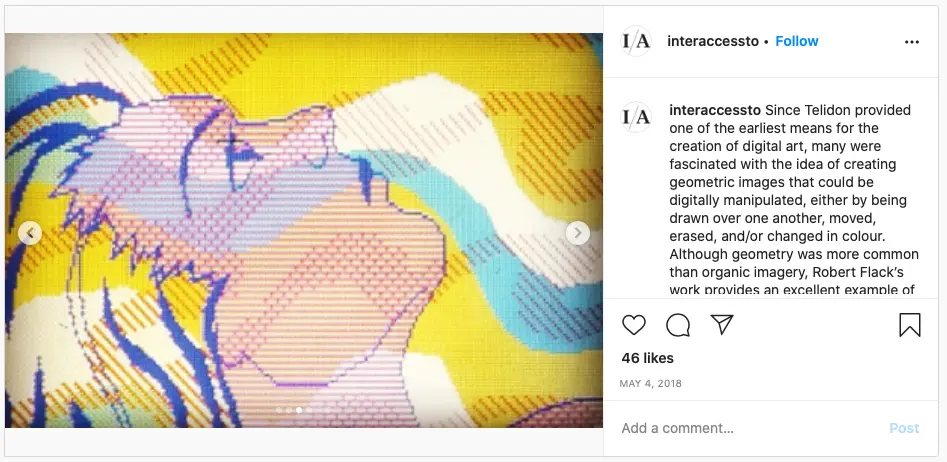
Figure 20: An Instagram post on the Inter/Access channel.Source: https://www.instagram.com/p/BiXJuo_nOiK/?taken-by=interaccessto (retrieved on April 2, 2020)
In each of their posts, Inter/Access featured the works of one artist. They usually added a half-dozen examples of the artist's work on Telidon and provided a short description.
For example, nine pieces by artist Adele D'Arcy were featured in her post (https://www.instagram.com/p/BhhBxuFncRk/?taken-by=interaccessto). The post description started with a quote from D'Arcy on the process of creating with Telidon: "The technology was frustrating to work with, especially the drawing function. You drew the image on paper first. Then you transferred it to the computer by taping it to a tablet and registering points along the drawn lines using a stylus that was huge by modern standards. This is why most Telidon drawings have a 'connect the dots' appearance. Crashes were frequent and spectacular, with a lot of noise, machine language and random dots and scribbles."
Then, the name of each piece is listed and, in some cases, a short description.
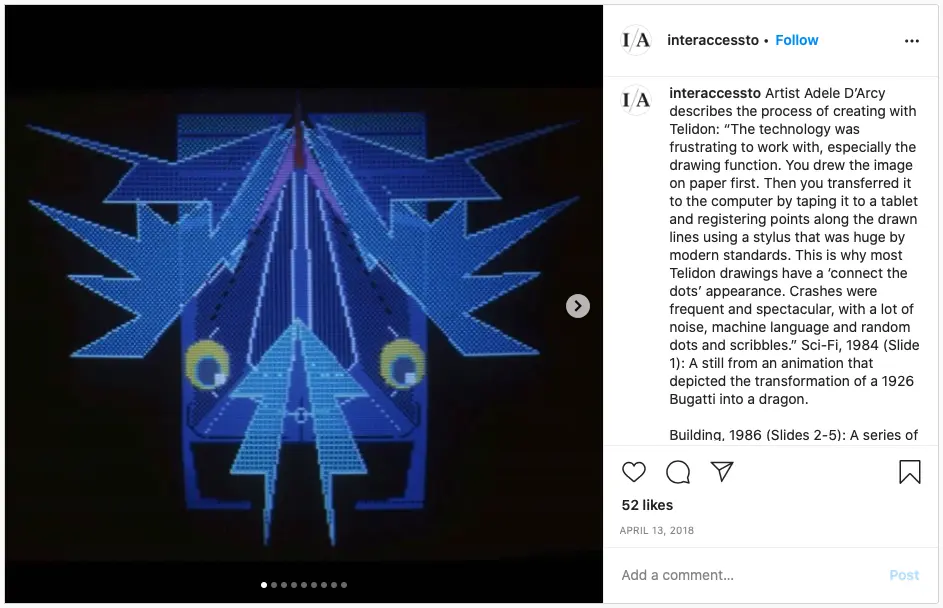
Figure 21: The Inter/Access Instagram post featuring the Telidon works of artist Adele D'Arcy. Source: https://www.instagram.com/p/BhhBxuFncRk/?taken-by=interaccessto (Retrieved on April 27, 2020)
The Inter/Access Telidon art collection on Instagram was a great success. Not only did thousands of individual users see the art produced on Telidon systems for the very first time, but the virtual exhibition reinvigorated interest in the old systems. A certain polite Canadian patriotism came to the forefront.
The featured Telidon artists were interviewed by technical media outlets, like Vice's Motherboard video channel. A ten-minute documentary brought the artists together again to show them their old art.
Other art libraries and research centers like Artexte started to discover Telidon art in their own collections or to conserve the works of Telidon artists. The University of Victoria Archive was gifted a collection of electronic artworks from the estate of the Glenn Howarth. And they started to figure out what to do with the data and how to conserve and present it on modern hardware.
In short, the Inter/Access #telidon Instagram exhibition gave Telidon greater exposure than it had even at its peak.
The Artists of the Inter/Access Telidon Collection
As noted above, the Instagram channel featured works of artists Bill Perry, Adele D'Arcy, Paul Petro, Robert Flack, Dennis Day, Douglas Porter, Pierre Rovere, Nell Tenhaaf, Johanne Daoust, and Nina Beveridge. Two of the most important artists are Nell Tenhaaf and Bill Perry. Let's look at them and their work, as well as the founder of Inter/Access, Paul Petro.
Nell Tenhaaf
Artist and later a professor, Nell Tenhaaf not only delivered one the most technically complex and in-depth pieces of art content on the Telidon system but also one of the most conceptually sophisticated pieces with Us and/or Them.
According to the Archive of Digital Art (ADA), Nell Tenhaaf is an "electronic media artist, writer and educator" who was born in 1951.[44]
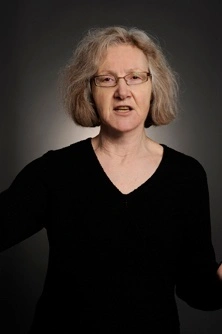
Figure 22: Nell Tenhaaf, Professor EmEritus, York University. Source: https://ampd.yorku.ca/profile/nell-tenhaaf/ (retrieved on April 15, 2020)
About Nell Tenhaaf
Nell Tenhaaf is an artist and author based in Trent Hills, Ontario. Born in Oshawa, she also lived in Montreal, Pittsburgh, and Toronto and now lives in Toronto with her husband and children.
In the early 1980s, Tenhaaf created groundbreaking artworks using Telidon and Videotex protocols for interactive graphics and texts, including Canada's first interactive video game, "Fitting and Unfit," which was shown at the Canadian Museum of Contemporary Art in Toronto in 1987. Her artworks integrate elements of life science and artificial life in the form of light boxes and interactive sculptures. Her work from the late 1980s to the 1990s is well-known and is considered a hybridization of the imperfections of human nature, a practice complicated only by the hybridization and imperfection of human nature.
Her later works represent part of the complex dynamics of life and involve the audience. They were activated video installations in which she was able to engage with the viewer in her artistic work. Tenhaaf has published numerous reviews and articles in publications such as The New York Times, The Wall Street Journal, and The Huffington Post. From 1999 to 2014, she was the curator of art at the Canadian Museum of Contemporary Art in Toronto, Canada. Her permanent collection includes works by artists such as Robert Rauschenberg, David Hockney, Paul Klee, Michael Krieger, John Pretzell, Robert F. Scott Fitzgerald, Mark Rothko, Andy Warhol, Frank Gehry, Richard Avedon, and many others.
The Professor Emeritus at York University in Toronto was an associate professor of art at the University of California, Berkeley, and a member of the board of trustees of the Canadian Museum of Contemporary Art.
After her stint working on Telidon art in the early 1980s, Tenhaaf went on to produce works that "propose the deconstruction of mainstream biological discourses and the cultural implications of biotechnologies and Artificial Life" (according to ADA).
In the 1970s, Tenhaaf got her B.F.A. at Concordia University, Montreal, and her diploma in art education at McGill University, Montreal. After her work on Telidon, Tenhaaf worked as a part-time educator at her alma mater, Concordia University. In the late 1980s, she completed her M.F.A. in open media at the same university and taught art at the University of Ottawa and then became a Replacement Professor there. In 1992, she was awarded the Corel Systems Award for the Bioapparatus project with Catherine Richards and The Banff Centre for the Arts.
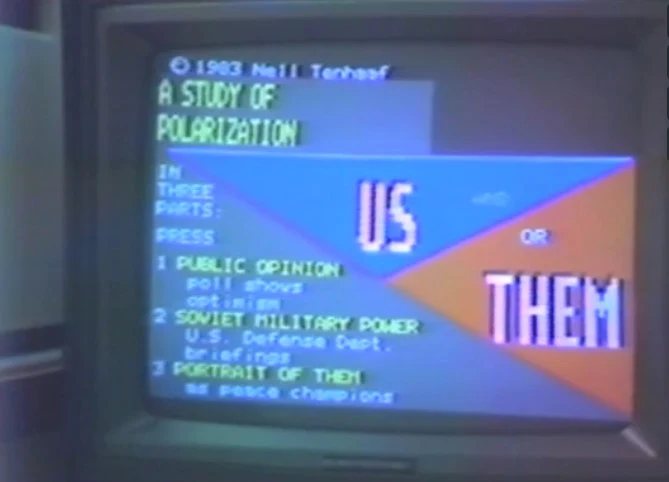
Figure 23: Us and/or Them, 1983. Source: https://www.aneddoticamagazine.com/us-and-or-them-1983/
After moving on to a position as a visiting assistant professor of art at the renowned Carnegie Mellon University in Pittsburgh, Tenhaaf became an assistant professor at York University in Toronto until her promotion to associate professor in 2000.
Us and/or Them
Nell Tenhaaf's digital magnum opus Us and/or Them was featured with one single image on the Inter/Access Instagram post about her (https://www.instagram.com/p/BhysmdeHC0Z/). But there is so much more behind it. Fortunately, there is a shaky video of most of the content of the piece on Vimeo (https://vimeo.com/68098468). In the video, recorded in 1983, likely as part of the Telidon program, a young Nell Tenhaaf walks the audience through her work.[45] Tenhaaf used the political environment of the Cold War as a source for her art. She embraced the propaganda to reveal the illusion of choice. She used data and information from Western media and from communist pamphlets for Us and/or Them.
Kim Sawchuk, a professor in the Department of Communication Studies at Concordia University in Montreal, described Nell Tenhaaf's remarkable work Us and/or Them as "Fifty pages of text, maps, and graphics on the Cold War, gathered from various information sources, including newspapers and United Nations reports, with manipulated images and graphics. This database established the analogy between the binary structure of information based on a Boolean logic of and/or and the deadlock of an us/them Cold War mentality."[46]
In the short Vice Motherboard documentary video The Lost Art of Canada's Doomed Pre-Internet Web, Nell Tenhaaf describes the meaning of her piece three decades after creating it as: "[It] was about the Cold War. We were [at the time] fed so much propaganda about our side being right and their side being wrong and bad… so I thought: that's interesting, so let's see what if you put it into question a little bit more?"[47]
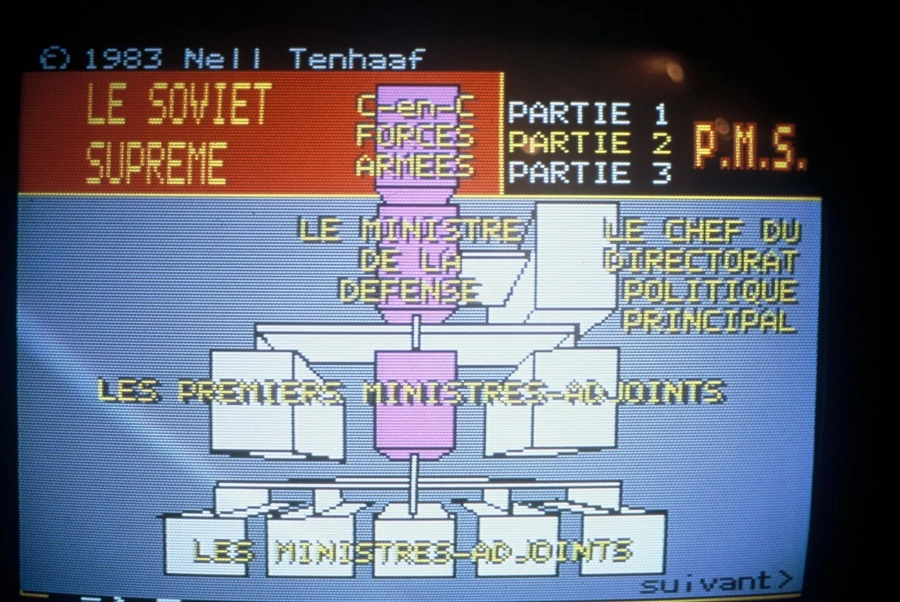
Figure 24: Nell Tenhaaf's "Us and/or Them".
Source:
http://ccca.concordia.ca/artists/work_detail.html?languagePref=en&mkey=65039&title=Us+and%2For+Them&artist=Nell+Tenhaaf&link_id=378
Produced in 1983 at the height of the Cold War, Nell Tenhaaf calls her work an interactive video database. The complete running time of the package is around 40 minutes, with some densely populated pages full of information. The work is a self-described "Study of Polarization."[48] The data represented is split into three distinct perspectives. The first is the public opinion on a topic, the second is data provided on this topic by the Western Allied nations, predominantly the United States, and the third is data on this subject provided by the Eastern Bloc nations, predominantly the Soviet Union.
Topic examples are the question in a Canadian Gallup poll on who will start a nuclear war. Public opinion was very much colored by the perceived affiliation and the great weight of the Cold War on the public conscience. The poll showed that 52% of polled Canadians thought that the USSR was more likely to start a nuclear war, while only 22% thought that e US would start it. Though, at the same time and in a separate question, most Canadians believed nuclear war to be unlikely (42%).
This information was presented in text form across multiple screens. Then, Tenhaaf made use of the advanced graphics capabilities and showed the poll results to the question, "On the issue of limiting nuclear weapons, who do you find more believable?" as isometric bars in a chart. Forty-two percent of the polled Canadians found then-US president Ronald Reagan to be more believable, with only 12% replying that short-lived Soviet leader Yuri Andropov to be more believable.
Us and/or Them goes on to break down each individual piece of data into graphics, e.g., a pie chart, a flat colored bar chart showing the public opinion on who was more likely to start a nuclear war. Tenhaaf then starts to juxtapose and overlay the different replies to the poll. According to the poll, the likely instigator of nuclear war was Russia; this is overlaid by the believability question, with the Russian leader coming in as far less believable than the US leader. The graphics build towards a frenzy when Tenhaaf erases the screen and places multiple pie charts that look like a dying Pac-Man with the mouth facing upwards. The main message here is "Yet it's not likely that there'll be a World War III" according to 42%. The percentage being reflected in the pie chart.
And this was only a small part of Us and/or Them Tenhaaf focused on what she called the intersections of art, science, and technology. Her interests were in biosciences and artificial life. Over the years, Tenhaaf tried to integrate elements from these different fields into her artwork in the form of light box displays and interactive sculptures.[49]
Bill Perry
Bill Perry is a Canadian artist, photographer, and some-time computer programmer. On Telidon, he created the online electronic magazine called Computerese: The Electronic Media Magazine. During Telidon's trial run, Computerese reached 1000+ homes and businesses in Quebec and Ontario.
When Perry originally heard of the Telidon program, he had no way of producing graphics for the system. The Norpak Creation terminals were not only expensive but very hard to get. Therefore, Perry reverse-engineered the Picture Creation System (PCS) and figured out how to write Telidon's graphics commands on an Apple II.
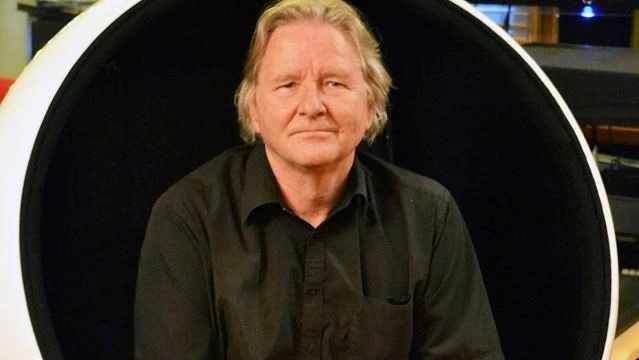
Figure 25: Bill Perry in 2014. Photo: Aurora Photography. Source: https://www.toronto.com/news-story/4873246-little-india-area-resident-bill-perry-s-pre-internet-work-showcased-in-art-show/ (retrieved on March 20, 2020)
Once he became part of the Telidon program, Perry set up a Norpak Creation machine in his house and conducted workshops to teach video artists the basics of computer graphics.
Bill Perry co-founded the Toronto Community Videotex together with Geoffrey Shea and Nina Beveridge; it is an artist-run cooperative, which was a hotbed for the Telidon art production. The program was a great success. In the Toronto Community Videotex, artists were also hackers and programmers. Perry helped create a forum for sharing tips on how to use technology. There were no gatekeepers over the work produced there, so the artists had fun and felt free to create whatever they wanted.
The Toronto Community Videotex became a natural arena for the exchange of ideas and discussions about art and technology. The cooperative eventually managed to apply for more government scholarships, and they got even more Norpak content creation terminals, as well as other computers.
In his life, Bill Perry contributed to and founded numerous art organizations and projects, e.g. Starside Softworks, Telidon at Trinity Square Video, Toronto Community Videotex, Videopage, The Colour Workshop, Comedia, The Copy Chai, and The Friday Cafe.[50]
Bill Perry's creation Computerese: The Electronic Media Magazine[51] was preserved by Artexte, a Canadian library, research center, and exhibition space for contemporary art.[52]

Figure 26: Bill Perry's Computerese, the electronic Media Magazine. (Source: https://artexte.ca/en/2017/11/artexte-on-air-around-computerese/, April 21, 2020)
Beside the Instagram post on Perry (https://www.instagram.com/p/BhPJVIpHo2y/?taken-by=interaccessto) as part of the Inter/Access exhibition, Computerese is only preserved as 55 images in Perry's collection. Some of the only remaining animated records of Computerese are a short video documentation called ART vs Art. This was a short film, which featured selections from a 21-day campaign/performance based on the 1982 Art Eggleton mayoral run. Also called This is No Job for Politicians, it was produced by three female artists called the Hummer Sisters who ran their own election campaign against Art Eggleton to become the mayor of Toronto, which explains the humorous name ART vs. Art. Based on concepts in the George Orwell novel about totalitarianism 1984, Bill Perry created the digital content for the Hummer sisters' campaign as part of his electronic magazine, Computerese. He then uploaded it to the Telidon servers and had it delivered to the households that were part of the Telidon trial.
The Artexte collection has conserved this documentary that was originally stored on a VHS cassette now as part of its digital collection.
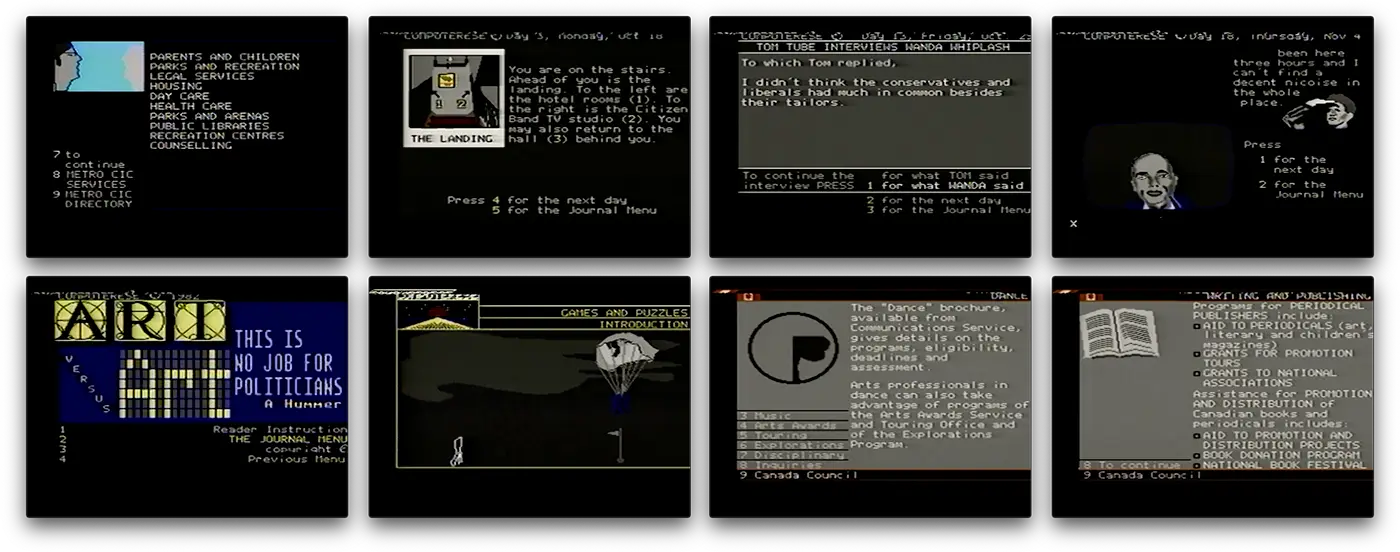
Figure 27: Excerpts from Computerese: The Electronic Media Magazine, 1982. Source: e-Artexte. https://e-artexte.ca/id/eprint/22646/
Paul Petro
Paul Petro is the director/curator of Paul Petro Contemporary Art, a gallery exhibiting Canadian and international artists. He also was part of the Toronto Community Videotex, the aforementioned hub of Telidon art activity in Toronto during the 80s. Inter/Access was born out of this community. He regards it as one of the world's largest and most successful open source software development companies.
Inter/Access was founded in 2003 as a non-profit organization for artists to give back to their local communities and the art community in general.
Petro and his Inter/Access team launched the Vector Festival in 2015, a gaming media arts festival focusing on creative media practices. The festival found support from a grant from the Danish Ministry of Culture, Art and Culture (MFA) and the Norwegian Council of Arts.
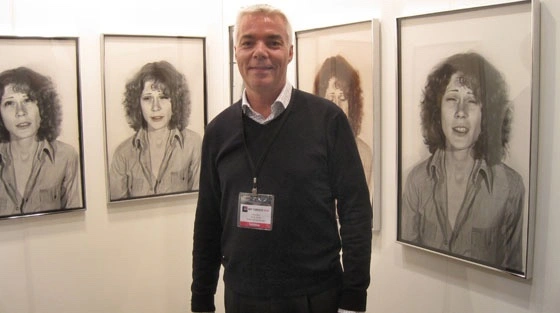
Figure 28: Artist and Curator Paul Petro at the 10th annual Toronto International Art Fair in 2009. Source: Art Net. http://www.artnet.com/magazineus/people/sokolow/sokolow11-24-09_detail.asp?picnum=11 (Retrieved on April 4, 2020)
Inter/Access also featured their founder Paul Petro's work on their Instagram #telidon channel.
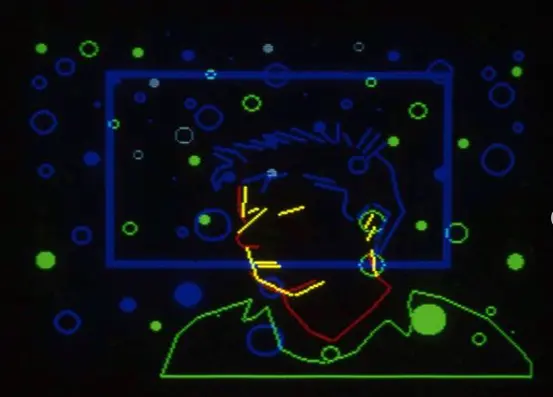
Figure 29: Electronic Self-portrait by Paul Petro. Source: Inter/Access Instragram channel
The first piece depicts an electronic self-portrait, and it is described as "The Individual Perspective, 1984 (Slide 1): A still from a time based sequence, depicting a self portrait of the artist, Paul Petro."
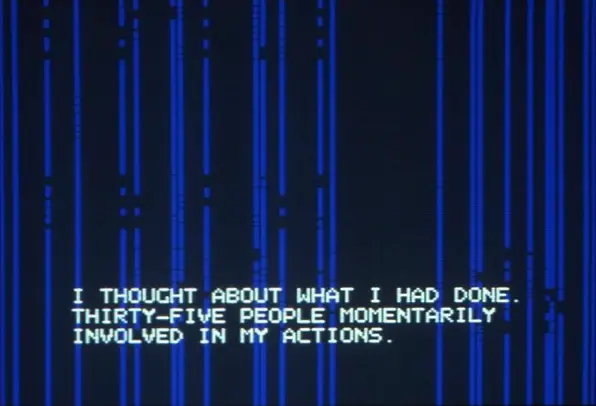
Figure 30: "My Media My Self by Paul Petro. Source: Inter/Access Instragram channel
The second piece is described as "My Media My Self (detail), 1984 (Slide 2): A computer graphic narrative, from a time based sequence."
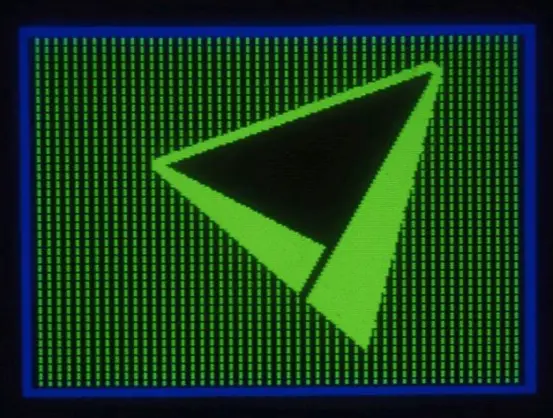
Figure 31: Image from Paul Petro's Triad Series. Source: Inter/Access Instragram channel
Images three to six are part of the Triad Series. The name was probably derived from a triangle, as depicted in the images, and not from organized crime. The description merely states: "Triad Series, 1983-1984 (Slides 3-5)"
Full Circle: Digital to Analog to Digital
Over the decades, Petro has held on to artifacts from the Telidon scene, and he keeps them in his art gallery. Petro produced art prints of photos of his Telidon work. This is quite transformative but also serves to conserve this digital art in a new analog shell.
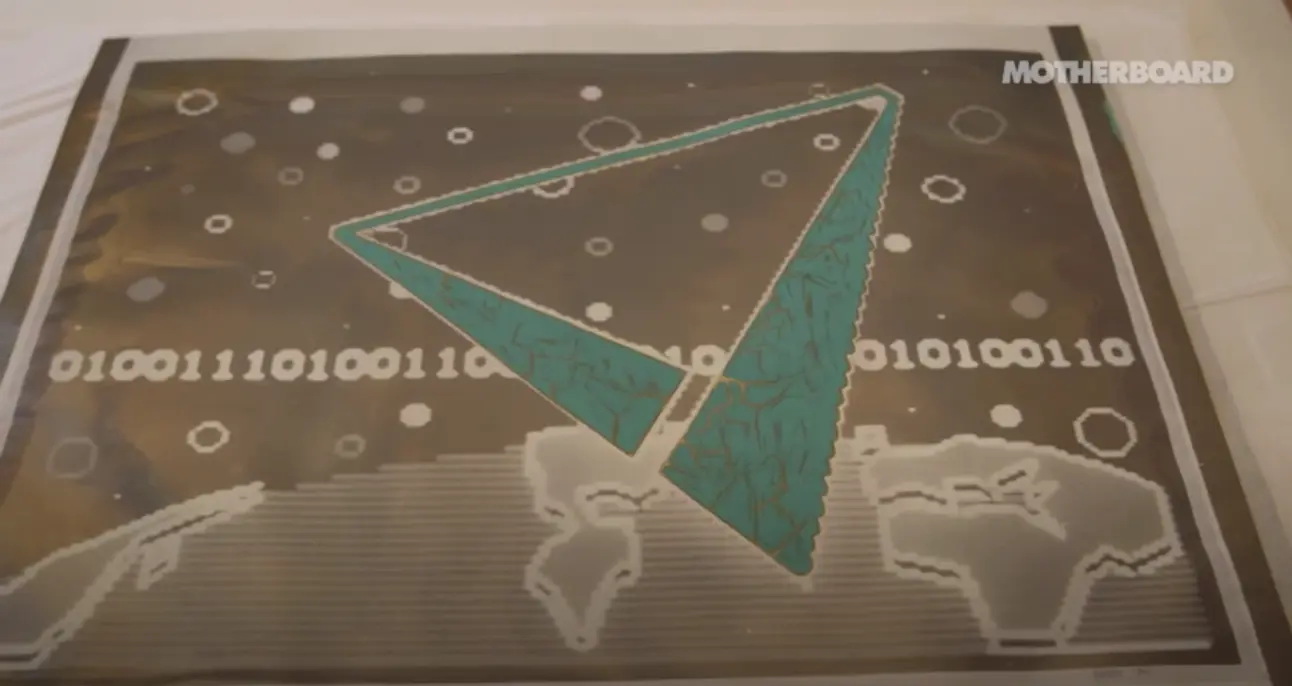
Figure 32: A still from the Vice Motherboard documentary, The Lost Art of Canada's Doomed Pre-Internet Web, showing one of Paul Petro's prints of his Telidon work. Source: The Lost Art of Canada's Doomed Pre-Internet Web. https://youtu.be/vjMUe7hkwRs (Retrieved on April 12, 2020)
This means that the purely digital art painstakingly produced on Norpak Telidon creation terminals in the early 80s were turned into analog video signals on a magnetic tape, and then stills of the video were used for the Instagram exhibition in 2018. The analog art prints will be used for many years to come. In a way, the digital artwork came full circle to its digital roots on Instagram via multiple analog media.
Footnotes
[42] Vice Motherboard:
The Lost Art of Canada's Doomed Pre-Internet Web
https://youtu.be/vjMUe7hkwRs
(Retrieved on March 12, 2020)
» Back [42]
[43] Inter/Access website.
https://interaccess.org
(Retrieved on March 8, 2020)
» Back [43]
[44] ADA, Archive of Digital Art.
https://www.digitalartarchive.at/database/artists/general/artist/tenhaaf.html
(Retrieved on March 8, 2020)
» Back [44]
[45] Tenhaaf, Nell. Us and/or Them. Vimeo.
https://vimeo.com/68098468
(Retrieved on January 8, 2020)
» Back [45]
[46] Tenhaaf, Nell. Works.
http://nelltenhaaf.ca/usthem.html
(Retrieved on March 15, 2020)
» Back [46]
[47] Vice Motherboard:
The Lost Art of Canada's Doomed Pre-Internet Web
https://youtu.be/vjMUe7hkwRs
(Retrieved on March 12, 2020)
» Back [47]
[48] Aneddotica Magazine. Us and/or Them (1983).
https://www.aneddoticamagazine.com/us-and-or-them-1983/
(Retrieved on April 19, 2020)
» Back [48]
[49] Inter/Access #telidon.
https://interaccess.org/exhibition/telidon
» Back [49]
[50] Inter/Access #telidon.
https://interaccess.org/exhibition/telidon
(retrieved on April 3, 2020)
» Back [50]
[51] e-Artexte.
https://e-artexte.ca/id/eprint/22646/(Retrieved on April 2, 2020)
» Back [51]
[52] Perry, Bill. ART vs Art: A Videotex Documentary
of a 21 day performance and 1982 mayoral campaign by the Hummer
Sisters and Videocabaret.
https://youtu.be/cjLXuX1mQXo
(retrieved on March 12, 2020)
» Back [52]